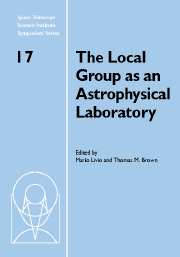 The Local Group as an Astrophysical Laboratory
The Local Group as an Astrophysical Laboratory Book contents
- Frontmatter
- Contents
- Participants
- Preface
- History of the Local Group
- Primordial nucleosynthesis
- Galactic structure
- The Large Magellanic Cloud: Structure and kinematics
- The Local Group as an astrophysical laboratory for massive star feedback
- Hot gas in the Local Group and low-redshift intergalactic medium
- Stages of satellite accretion
- The star formation history in the Andromeda halo
- Bulge populations in the Local Group
- The Local Group as a laboratory for the chemical evolution of galaxies
- Massive stars in the Local Group: Star formation and stellar evolution
- Massive Young Clusters in the Local Group
- Magellanic Cloud planetary nebulae as probes of stellar evolution and populations
- The old globular clusters: Or, life among the ruins
- Chemical evolution models of Local Group galaxies
The old globular clusters: Or, life among the ruins
Published online by Cambridge University Press: 12 May 2010
- Frontmatter
- Contents
- Participants
- Preface
- History of the Local Group
- Primordial nucleosynthesis
- Galactic structure
- The Large Magellanic Cloud: Structure and kinematics
- The Local Group as an astrophysical laboratory for massive star feedback
- Hot gas in the Local Group and low-redshift intergalactic medium
- Stages of satellite accretion
- The star formation history in the Andromeda halo
- Bulge populations in the Local Group
- The Local Group as a laboratory for the chemical evolution of galaxies
- Massive stars in the Local Group: Star formation and stellar evolution
- Massive Young Clusters in the Local Group
- Magellanic Cloud planetary nebulae as probes of stellar evolution and populations
- The old globular clusters: Or, life among the ruins
- Chemical evolution models of Local Group galaxies
Summary
Recent progress on the astrophysics of globular clusters is discussed. Highlights are (a) developments in color-magnitude survey work, (b) globular cluster structures and the “fundamental plane,” and (c) the relation between globular clusters and the halo field stars in the same host galaxy.
Color-Magnitude studies: The beginning and end of an era
Above almost all other types of astronomical systems, globular clusters offer the chance to take a broad historical perspective. Much of the history of astrophysics in the twentieth century—stellar structure, stellar evolution, the distance scale, galactic structure and evolution, stellar populations, variable stars, high-energy sources—was driven by the need to understand the complex array of phenomena taking place inside these dense stellar systems.
No review of this kind should fail to mention the continuing efforts to understand the stellar content of these elegant systems through color-magnitude studies (CMDs), which are penetrating to ever-greater detail and depth. The very first such studies (see, for example, Shapley & Davis 1920) barely showed the red-giant stars and brightest horizontal-branch stars for the nearest clusters. This past year, a watershed in this kind of basic color-magnitude survey work was reached with the publication of the monumental survey project of Piotto et al. (2002), who used the WPFC2 camera on board HST to obtain (B, V) CMDs for 74 globular clusters, very nearly half of the entire Milky Way globular cluster population. The objects range from nearby, high-latitude clusters with beautifully precise, classic CMD sequences, down to sparse objects deeply embedded in the heavy field contamination and differential reddening of the Galactic bulge.
- Type
- Chapter
- Information
- The Local Group as an Astrophysical LaboratoryProceedings of the Space Telescope Science Institute Symposium, held in Baltimore, Maryland May 5–8, 2003, pp. 208 - 214Publisher: Cambridge University PressPrint publication year: 2006


